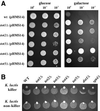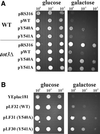Saccharomyces cerevisiae Elongator mutations confer resistance to the Kluyveromyces lactis zymocin
- PMID: 11296232
- PMCID: PMC125238
- DOI: 10.1093/emboj/20.8.1993
Saccharomyces cerevisiae Elongator mutations confer resistance to the Kluyveromyces lactis zymocin
Abstract
Kluyveromyces lactis killer strains secrete a zymocin complex that inhibits proliferation of sensitive yeast genera including Saccharomyces cerevisiae. In search of the putative toxin target (TOT), we used mTn3:: tagging to isolate zymocin-resistant tot mutants from budding yeast. Of these we identified the TOT1, TOT2 and TOT3 genes (isoallelic with ELP1, ELP2 and ELP3, respectively) coding for the histone acetyltransferase (HAT)-associated Elongator complex of RNA polymerase II holoenzyme. Other than the typical elp ts-phenotype, tot phenocopies hypersensitivity towards caffeine and Calcofluor White as well as slow growth and a G(1) cell cycle delay. In addition, TOT4 and TOT5 (isoallelic with KTI12 and IKI1, respectively) code for components that associate with ELONGATOR: Intriguingly, strains lacking non-Elongator HATs (gcn5, hat1, hpa3 and sas3) or non-Elongator transcription elongation factors TFIIS (dst1) and Spt4p (spt4) cannot confer resistance towards the K.lactis zymocin, thus providing evidence that Elongator equals TOT and that Elongator plays an important role in signalling toxicity of the K.lactis zymocin.
Figures








Similar articles
-
Protein interactions within Saccharomyces cerevisiae Elongator, a complex essential for Kluyveromyces lactis zymocicity.Mol Microbiol. 2002 Aug;45(3):817-26. doi: 10.1046/j.1365-2958.2002.03055.x. Mol Microbiol. 2002. PMID: 12139626
-
Molecular analysis of KTI12/TOT4, a Saccharomyces cerevisiae gene required for Kluyveromyces lactis zymocin action.Mol Microbiol. 2002 Feb;43(3):783-91. doi: 10.1046/j.1365-2958.2002.02794.x. Mol Microbiol. 2002. PMID: 11929532
-
Kluyveromyces lactis zymocin mode of action is linked to RNA polymerase II function via Elongator.Mol Microbiol. 2001 Nov;42(4):1095-105. doi: 10.1046/j.1365-2958.2001.02705.x. Mol Microbiol. 2001. PMID: 11737649
-
Zymocin, a composite chitinase and tRNase killer toxin from yeast.Biochem Soc Trans. 2007 Dec;35(Pt 6):1533-7. doi: 10.1042/BST0351533. Biochem Soc Trans. 2007. PMID: 18031261 Review.
-
Plant Elongator-mediated transcriptional control in a chromatin and epigenetic context.Biochim Biophys Acta. 2016 Aug;1859(8):1025-33. doi: 10.1016/j.bbagrm.2016.06.008. Epub 2016 Jun 21. Biochim Biophys Acta. 2016. PMID: 27354117 Review.
Cited by
-
hElp3 directly modulates the expression of HSP70 gene in HeLa cells via HAT activity.PLoS One. 2011;6(12):e29303. doi: 10.1371/journal.pone.0029303. Epub 2011 Dec 21. PLoS One. 2011. PMID: 22216241 Free PMC article.
-
Mutant casein kinase I (Hrr25p/Kti14p) abrogates the G1 cell cycle arrest induced by Kluyveromyces lactiszymocin in budding yeast.Mol Genet Genomics. 2003 May;269(2):188-96. doi: 10.1007/s00438-003-0807-5. Epub 2003 Feb 13. Mol Genet Genomics. 2003. PMID: 12756531
-
Pichia acaciae killer system: genetic analysis of toxin immunity.Appl Environ Microbiol. 2007 Jul;73(13):4373-8. doi: 10.1128/AEM.00271-07. Epub 2007 May 4. Appl Environ Microbiol. 2007. PMID: 17483256 Free PMC article.
-
The yeast elongator histone acetylase requires Sit4-dependent dephosphorylation for toxin-target capacity.Mol Biol Cell. 2004 Mar;15(3):1459-69. doi: 10.1091/mbc.e03-10-0750. Epub 2004 Jan 12. Mol Biol Cell. 2004. PMID: 14718557 Free PMC article.
-
Loss of wobble uridine modification in tRNA anticodons interferes with TOR pathway signaling.Microb Cell. 2014 Nov 29;1(12):416-424. doi: 10.15698/mic2014.12.179. Microb Cell. 2014. PMID: 28357221 Free PMC article.
References
-
- Ahmed A., Sesti,F., Ilan,N., Shih,T.M., Sturley,S.L. and Goldstein,S.A. (1999) A molecular target for viral killer toxin: TOK1 potassium channels. Cell, 99, 283–291. - PubMed
-
- Becker D.M., and Guarente,L. (1991) High-efficiency transformation of yeast by electroporation. Methods Enzymol., 194, 182–187. - PubMed
-
- Berben G., Dumont,J., Gilliquet,V., Bolle,P.A. and Hilger,F. (1991) The YDp plasmids: a uniform set of vectors bearing versatile gene disruption cassettes for Saccharomyces cerevisiae. Yeast, 7, 475–477. - PubMed
-
- Brown C.E., Lechner,T., Howe,L. and Workman,J.L. (2000) The many HATs of transcription coactivators. Trends Biochem. Sci., 25, 15–19. - PubMed
Publication types
MeSH terms
Substances
LinkOut - more resources
Full Text Sources
Molecular Biology Databases

